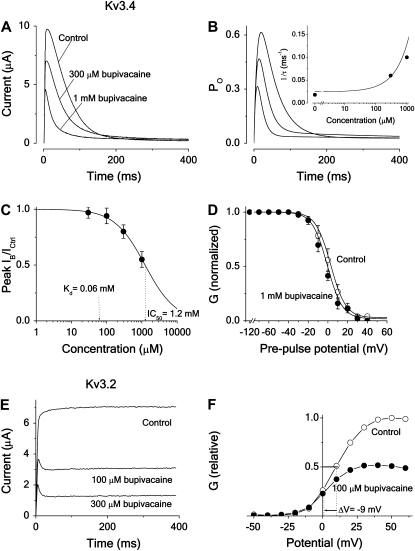FIGURE 8.
Effect of bupivacaine on inactivating and noninactivating Kv3-type channels. (A) Time course of Kv3.4 current at a voltage step to +60 mV from a holding potential of −80 mV in 300 μM and 1 mM bupivacaine, and in control solution. Note the crossing-over effect at 150 and 220 ms, respectively. (B) Computed time course of the open probability (Po) of Scheme 5, using activation and inactivation values listed in Table 1, and binding rates listed in Table 2. (Inset) Effect of bupivacaine concentration on the fast component of the decay phase. The continuous line shows the concentration dependence of inverted time constants (1/τ) of the fast component, calculated as largest eigenvalues from the matrix equation derived for Scheme 5 in Appendix B, using the values of Tables 1 and 2. Solid circles (•) show experimental values, estimated from the curves in panel A by fitting a sum of two exponentials to the decaying phase (between t = 20 and 40 and 200 ms). (C) Dose-response curve (Eq. 1) fitted to mean peak currents (•) at +60 mV (n = 10). Resulting IC50 is 1.2 mM. (D) Steady-state inactivation curve of Kv3.4 in 1.0 mM bupivacaine (•) and in control (○) solution. Measured currents evoked by a 50 ms test pulse to +30 mV, from a conditioning prepulse of 400 ms duration, plotted versus potential (n = 5). Continuous lines are calculations for Scheme 5 (see Appendix A). (E) Time course of Kv3.2 current at a voltage step to +60 mV from a holding potential of −80 mV in 100 and 300 μM bupivacaine, and in control solution. (F) Steady-state G(V) curves (Eq. 2) for Kv3.2 in 100 μM bupivacaine (•) and in control (○) solution. Same experiment as in panel E.

